Geological disaster refers to the movement of rock and soil mass, which is caused by natural or man-made action, and in most cases is caused by the synergistic action of the two, and destroys human life and property and living environment in the earth surface. Geological disasters have the dual nature of natural evolution and man-made induction in the cause, which is not only a component of natural disasters, but also belongs to the category of man-made disasters. In a sense, geological disaster is already a problem with social attributes, and has become an important factor restricting social and economic development and people’s livelihood. Therefore, the prevention and control of geological disasters not only refers to the prevention, avoidance and engineering management, but also manifests in the high-level social consciousness as efforts to improve the quality of human beings themselves, and consciously protect the geological environment through the formulation of public policies or government legislation to restrict the behavior of the public, so as to achieve the purpose of avoiding or reducing geological disasters. Geological disasters mainly refer to collapse (i.e., dangerous rock mass), landslide, debris flow, karst ground collapse and ground cracks, etc., which are more commonly recognized as the drastic changes in the geological structure of the original crust, and are generally considered to be sudden. Geological environmental disaster refers to the hazards caused by regional geological ecological environment variation, such as regional land subsidence, seawater intrusion, desertification in arid and semi-arid areas, soil erosion in rocky mountain areas, rocky desertification and frequent flooding in plain or basin areas under the background of regional geological structure settlement, etc. These problems are usually caused by multiple factors and occur slowly. It is often referred to as a gradual geological hazard in geological circles.
The geomorphic unit of this point is a basin, with a steep slope and a block like structure composed of granite. The rock is strongly weathered, with well-developed joints and fissures. The vegetation is mostly shrubs, with a small amount of trees, and there is no human engineering activity. The collapse source is formed by a steep and negative terrain, with a length of about 150 meters, a width of about 10 meters, and a thickness of about 2 meters. A set of joint fissures is developed, with a convex shape on the plane. The rock is granite, and the weathering is relatively strong. The collapse path is to fall down the slope and then roll down to the foot of the slope, with a small amount of scattered rolling stones currently present. The hidden danger point of the collapse is currently in the initial cracking stage, with a small amount of scattered rolling stones and no obvious cracks in some areas at the slope corner. It is currently in a basically stable state and may experience instability under the influence of rainfall, earthquakes and other triggering factors, leading to collapse. It poses a threat to the road below Mengba Giant Rock and local pedestrians. As the road is a simple road with fewer people passing by, the degree of harm is relatively low.
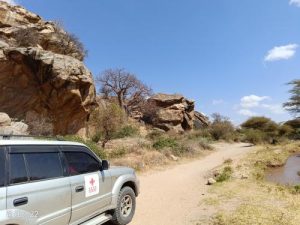
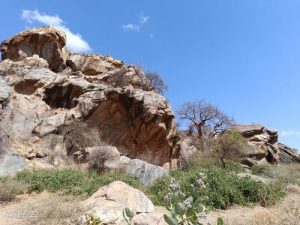
The geomorphic unit of this point is a basin, with a steep slope and a gneiss like structure. The joints and fissures are well-developed, and there are sparse shrubs on the slope top and fracture surface, without human engineering activities. The terrain slope of the collapse source area is about 550 meters, with a length of about 150 meters, a width of about 10 meters, and a thickness of about 4 meters. The rock is composed of gneiss, metamorphic structure, gneiss like structure, developed joint fissures, and a rock block size of about 0.6 x 1.5 x 2 meters. The rock is strongly weathered. The collapse path is for the collapse body to slide along the joint and fissure surface to the slope corner. The hidden danger point of collapse is currently in a basically stable state, with well-developed joints and cracks. Under the influence of triggering factors such as rainfall and earthquakes, collapse may occur. This hidden danger mainly poses a threat to nearby residents, including 7 households with about 30 people, 7 brick and concrete houses, and 6 adobe houses, posing a threat to property worth 280000 yuan. The number of threats ranges from 10 to 100 people, with a moderate degree of harm.
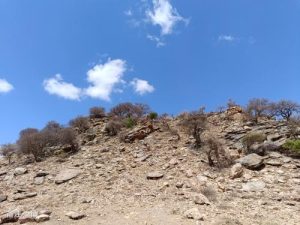
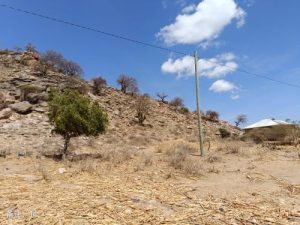
The geomorphic unit of this point is a basin, with a steep slope as the micro landform. The lithology is granite, with a medium to coarse grain structure and a block like structure. The rock is strongly weathered, with well-developed joints and fissures. The vegetation is shrubs, and there is no human engineering activity. The collapse source is an isolated and dangerous rock mass, approximately 25m long, 12m high, and 5m wide. The rock is granite with strong weathering and currently has joints and cracks. The collapse path is to fall down the slope and then pile up to the foot of the slope. Currently, there are scattered deposits in the collapse path area. The hidden danger point of the collapse is currently in the initial cracking stage, with developed joints and cracks on the slope. It is currently in a basically stable state and may become unstable under the influence of triggering factors such as rainfall and earthquakes, resulting in collapse. This point is an isolated and dangerous rock mass, with a height of about 12m and a length of about 25m. There is relatively little human activity and the degree of harm is small.
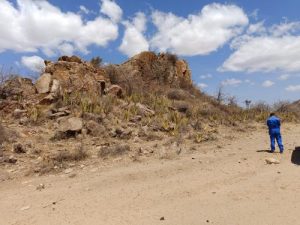
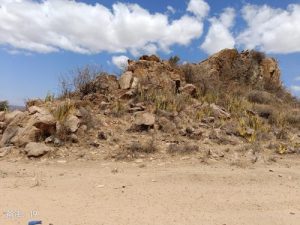
The geomorphic unit of this point is a basin, with a steep slope as the micro landform. The lithology is granite, with a medium to coarse grain structure and a block like structure. The rock is strongly weathered, and the vegetation is shrubs. There is no human engineering activity. The collapse source is formed by steep slope terrain, with a length of about 100m, a width of about 3m, and a thickness of about 2m. The joint fissures are well-developed, and the rock is granite with strong weathering. The collapse path is that the rock falls downwards along the structural plane under the combination of weathered joints and fissures, and accumulates at the slope angle under the inducing factors. The hidden danger point of the collapse is currently in the initial cracking stage, with a small amount of scattered rolling stones in some areas. It is currently basically stable and may become unstable under the influence of triggering factors such as rainfall and earthquakes, resulting in collapse. This hidden danger mainly poses a threat to nearby residents, including 2 households with about 12 people, 3 brick and concrete houses, and 2 adobe houses, posing a threat to property worth 160000 yuan. The number of threats ranges from 10 to 100 people, with a moderate degree of harm.
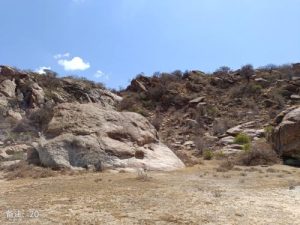
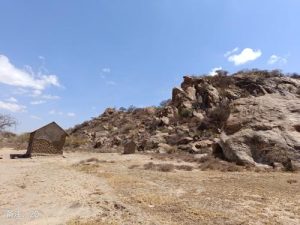
The terrain and topography of this point are Zhongshan, with steep cliffs as the micro terrain. The upper part is composed of calcareous tuff, gray white, with multiple sets of vertical joints. The bottom is composed of basalt, gray black, and the slope is nearly horizontal layered. The vegetation is shrubland, and human engineering activities are road construction. The collapse source area is mainly a dangerous rock mass formed by calcareous tuff due to columnar joints, with a spacing of about 1 meter and a depth of about 8 meters between the columnar joints. The collapse path area is a dangerous rock mass that rolls and jumps on the slope after dumping, with a maximum distance of about 60m. At present, the dangerous rock mass is in a basically stable state, and may experience instability and collapse under triggering factors such as rainfall and earthquakes. This is an undeveloped scenic spot, with inconvenient road traffic and limited human traffic, resulting in a low level of harm.
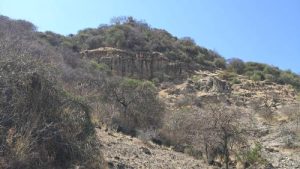
The terrain and topography of this point are Zhongshan, with steep cliffs as the micro terrain. The upper part is composed of calcareous tuff, gray white, with multiple sets of vertical joints. The bottom is composed of basalt, gray black, and the slope is nearly horizontal layered. The vegetation is shrubland, and human engineering activities are road construction. The collapse source area is mainly a dangerous rock mass formed by calcareous tuff due to columnar joints, with a spacing of about 1 meter and a depth of about 8 meters between the columnar joints. The collapse path area is a dangerous rock mass that rolls and jumps on the slope after dumping, with a maximum distance of about 60m. At present, the dangerous rock mass is in a basically stable state, and may experience instability and collapse under triggering factors such as rainfall and earthquakes. This is an undeveloped scenic spot, with inconvenient road traffic and limited human traffic, resulting in a low level of harm.


The terrain of the collapse site is steep, almost upright, and the terrain is mountainous. The lithology of the formation is tuff block structure, with developed unloading cracks. On the left is a gully without water, with high vegetation coverage, mostly trees, shrubs, and grass, and no human engineering activities. The source area of the collapse is volcanic rock, with a fine-grained structure and a block like structure. The unloading cracks are developed, and the rock blocks are approximately (0.5-2) long x (0.5-1) wide x (3-5m) high. The cracks are 2-10cm wide, with no filling – a small amount of filling, and the crack surface is rough. The collapse path tilts downwards along the slope, rolling down the foot of the slope, and the falling rocks are about 30 x 40 x 50cm The hidden danger of collapse is currently in a basically stable state, and collapse may occur in the future under factors such as rainfall and earthquakes This hidden danger mainly poses a threat to tourist mountaineers, with a relatively low degree of harm.
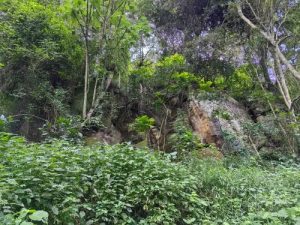
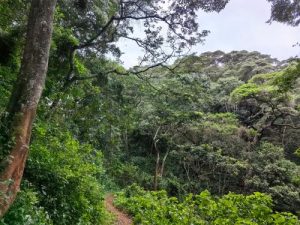
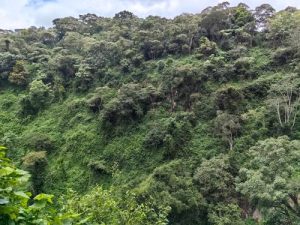
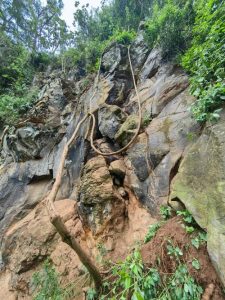
The surrounding terrain of this hidden danger point is steep, with a slope of 50-70 °. The terrain is a low mountain in a volcanic crater, and the roadbed slope is manually excavated. The lithology of the formation is a mixture of Quaternary residual soil and rock mixed with crushed stone soil. The soil is completely weathered tuff powder, with a crushed stone content of about 50-70%. The block size is 3-150cm, and the sorting is poor, with an angular shape. The parent rock is composed of tuff (volcanic rock), and there is no water in the surrounding area. The surface vegetation is covered, mainly by herbs and shrubs, Human engineering activities mainly involve excavating mountain roads, with a roadbed width of approximately 3-4m The source area of the potential collapse hazard is the slope of the entrance road to the Engro Huoshan Pass, which is residual gravel soil with a maximum block diameter of up to 1.5m. The slope is steep, with a slope of 60 ° -80 °. The roadbed side is exposed, with visible fragments, with a block diameter of 10-30cm. The upper part of the slope is covered with vegetation. The collapse path falls downwards along the slope to the foot of the slope, with a maximum distance of 50m along the slope, usually 20m, and piles up at the foot of the slope. The hidden danger point is currently in a basically stable unstable state, with a small amount of falling stones visible on the roadbed. In the future, under triggering factors such as rainfall, larger stones may fall, affecting the safety of passing vehicles. The hidden danger point is currently in an unstable state and is prone to collapse under triggering factors such as rainfall and vibration excavation, causing harm to passing tourist vehicles with a moderate degree of harm. Tourist vehicles can accommodate 5-9 people, with a moderate to high degree of harm.

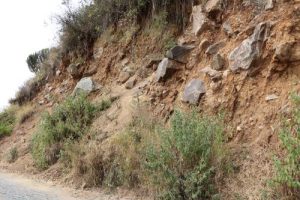
The surrounding terrain of this point is steep, with a natural slope of 40-60 ° and an artificial slope of 80 °. The excavation face is about 10 meters high, and at the foot of the slope is a boundary between granite and tuff. The upper part of the tuff has a pink surface and a greenish gray interior, with a cryptocrystalline structure, block like structure, developed joints, and a relatively broken upper rock mass. The excavation surface is exposed, and the rest of the vegetation is covered. The roadbed is about 3 meters wide, and this is a turning point. The road is paved with crushed stone bricks, and there are no other human engineering activities. The collapse source area is an artificially excavated surface, which is nearly upright. The rock structure on the slope is relatively fragmented, with developed joint fissures and a width of about 1-2cm The collapse path falls downwards along the slope and is piled up at the foot of the slope. The maximum distance of the collapse reaches the bottom of the volcanic crater below the slope. The diameter of the rolling stones is relatively small, usually 5-30cm, and they fall irregularly in a straight line. The hidden danger point of the collapse is currently in a basically stable state, with some parts in an unstable state. In the future, it may lead to rockfall and other collapse phenomena under triggering factors. The volume of the collapse source is about 5000m3, which can cause rockfall under triggering factors, with a moderate degree of harm, mainly endangering passing tourist vehicles.
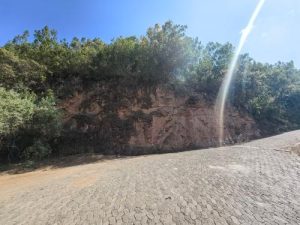

The surrounding terrain of this hidden danger point is steep, with a slope of 40 ° -60 °. The point is a manually excavated roadbed slope, with a steep slope surface of nearly 90 °, exposed, and composed of volcanic conglomerate and fragmented structure. The slope surface is devoid of vegetation, and the foot of the slope is a manually constructed road of about 4 meters. The main source area of collapse is the slope formed by manual excavation of the roadbed, with exposed excavation surface and broken rock mass, with a height of about 10-15m and a length of about 80-100m. The collapse is mainly caused by external forces on the upper and middle rock masses, and the original slope surface above the excavation surface is covered with vegetation. The collapse path mainly falls downwards along the slope, with the most likely vertical distance of 15m and a horizontal distance of 2-5m. The falling stones are mainly piled up at the foot of the slope roadbed, and a small amount can roll along the original slope surface to the bottom of the volcano. The hidden danger point is close to upright and in a state of ultimate equilibrium, which may cause collapse phenomena such as falling blocks and rocks under external forces. The hidden danger point is formed by manual excavation to form a nearly upright roadbed slope, which is most likely to cause falling stones along the excavation surface, endangering the safety of passing tourist vehicles and tourists, with a moderate degree of harm.
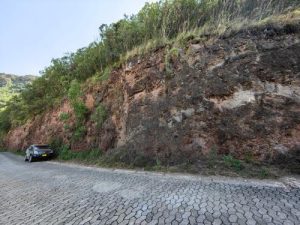

The surrounding terrain of this hidden danger point is steep, with a slope of 40 ° -60 °. The terrain type is volcanic crater, medium low mountain terrain, and the lithology of the formation is volcanic conglomerate. The slope is a high and steep slope formed by manual excavation of the roadbed, with broken rock mass and no groundwater. The excavation surface shows exposed bedrock, with other vegetation covering it. The roadbed is about 3m wide, paved with crushed stone bricks, and there is no other human engineering activities. The collapse source area is a manually excavated slope, with a steep excavation surface and fragmented rock mass. The size of the rock blocks is 1.5 x 1.0 x 0.5 meters, and the local bedrock is exposed to volcanic conglomerate, with the remaining vegetation covering it. The collapse path falls or rolls down the slope, mostly piled up at the edge of the roadbed, and a small amount rolls down the original slope to the lower part of the volcano. The hidden danger point of the slope is currently in a basically stable state. Due to the fragmentation of the slope rock mass, external forces may induce rockfall and other collapse disasters. The hidden danger point is formed by manually excavating the roadbed to form a steep slope, which can cause collapse phenomena such as falling rocks under external forces, endangering the safety of passing tourist vehicles and tourists, but the degree of harm is not high.
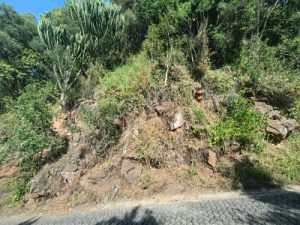
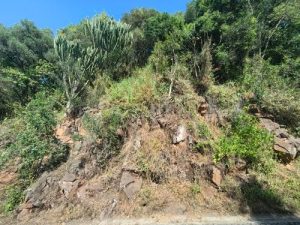
The surrounding terrain of this point is steep, with a terrain of medium to low mountains and hills, with a slope of 30-50 °. The lithology of the strata is volcanic tuff and volcanic ash, a combination of hard and soft strata. The area is also formed by manual excavation, with a slope of about 60-70 °. The rock mass is fragmented, and the surrounding vegetation is covered. Below the foot of the slope is farmland. The collapse source area is located on the south side of the highway, forming a free face for road construction and excavation. The rock mass in the source area is broken and fragmented, with a diameter of 30-80cm. The residual soil on the surface slope is thin, 10-30cm, covered with vegetation, and the free face is exposed. The collapse path rolls down the slope, piled up at the edge of the roadbed, and can roll down to the farmland at the farthest point. The slope is currently in a basically stable unstable state, and during the rainy season, it can cause the rolling of rocks under the induction of rainfall. The hidden danger point is currently in a basically stable unstable state, which can form collapse under triggering factors such as rainfall, seriously affecting the safety of passing vehicles and personnel, with a moderate degree of harm.
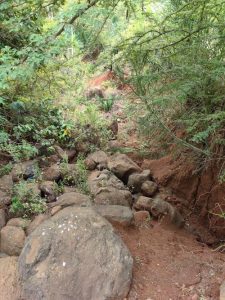
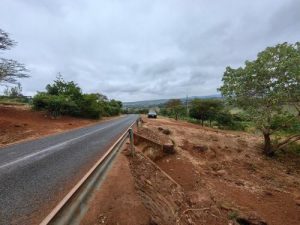
The terrain of the collapse site is steep, with hilly terrain and volcanic rock formations. The rock mass is fragmented and has developed joints, with a slope of 40-70 °. Most of the surface has been exposed, with a small number of cactus trees visible. There is only one road around, paved with gravel, and no other human engineering activities. The terrain of the collapse source area is steep, with a slope of 50 ° -70 °. The rock mass is fragmented, with vertical joints developed, and the rock mass is fragmented, with a block size of about 0.3 × 0.5 × 1.5m The collapse path falls down along the mountain, with a path that is approximately straight and piled up at the foot of the slope. The collapse point is currently in a basically stable unstable state, and can cause collapse phenomena such as falling rocks under triggering factors such as rainfall and earthquakes. The collapse point mainly falls down the mountain in the form of rolling stones, which mainly endangers the safety of pedestrians and vehicles passing by the slope foot road, and the degree of harm is relatively small.
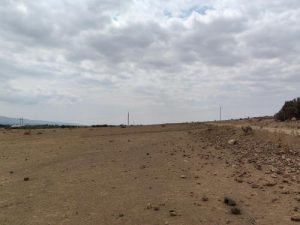
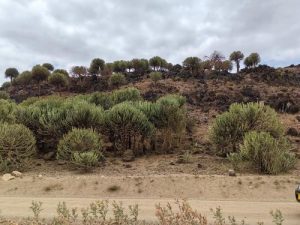
This point is located in a gully, with volcanic breccia as the lithology. The steep slope is nearly upright, with a combination of tuff/breccia/tuff. The surface is covered with shrubs and a small amount of trees. There is a road at the top of the slope, which is about 5m wide and paved with gravel. The top of the collapse source slope is relatively gentle, and the slope surface is nearly upright, consisting of volcanic breccia with developed vertical joints and unstable rock structure. The collapse path tilts downwards along the slope and rolls into the ditch. The collapse hazard point is currently in a state of extreme equilibrium and can cause collapse under factors such as rainfall. The hidden danger point is located on the east side of the highway roadbed, collapsing towards the direction of the highway, endangering the highway and passing vehicles and pedestrians, with a relatively low degree of harm.
The surrounding terrain of this point is relatively gentle, with a slope of 5-15 °. The terrain type is volcanic terrain, and the rock layers in this area are piled up with crushed stones, disorderly and disorderly, with a block size of 2-500mm. The sorting is poor, and the grading is good. The artificial excavation forms a slope of nearly 80 °, without water. The surface is covered with vegetation mainly composed of grass and shrubs. The collapsed park is a small hill that may have been formed by volcanic eruption and accumulation. The gravel is disorderly and of varying sizes, with a slope gradient of about 15 °. The artificial excavation forms a slope of about 80 °, with vegetation covering the top of the slope and the slope surface exposed. The collapse path falls down along the excavation face to the highway. The potential collapse point is currently in a limit equilibrium state, and may collapse under rainstorm, manual excavation and other factors. The scale of the collapse hazard point is relatively small, mainly causing harm to passing vehicles and pedestrians, and the degree of harm is relatively low.
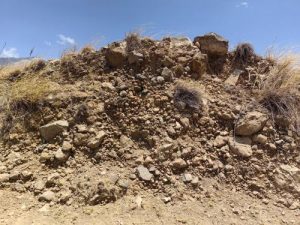
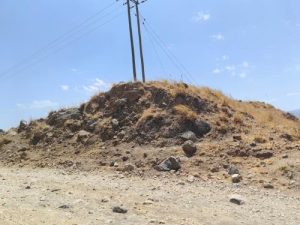
This point is located 180m away from the west side of the Lungai volcanic crater, where cracks are developed. The surrounding terrain is steep, with a slope of 30-50, and the terrain type is volcanic crater landform. The surface lithology is volcanic breccia, tuff, gray black, layered, with a rock attitude of 312 ° ∠ 15 °. The rock strength is high, and the gravel diameter is about 2-50mm, with a maximum of 100mm. It is in an angular to sub angular shape, and the surface of the rock layer is accompanied by white carbonate rock with good crystallization, resembling cauliflower. A crack with a width of about 20-50cm is developed in the source area of the collapse, and H2S gas is locally emitted. The outer rock structure is composed of volcanic breccia and tuff, with an inclination angle of about 20 °. The collapse path is prone to collapse towards the foot of the mountain under the action of vibration. The hidden danger point is currently in a basically stable state, and instability may occur under the action of earthquakes or volcanic eruptions and vibrations The collapse hazard point is prone to collapse towards the foot of the mountain under the action of vibration. Due to the lack of human habitation and fewer tourists going up the mountain, the degree of harm is relatively low.
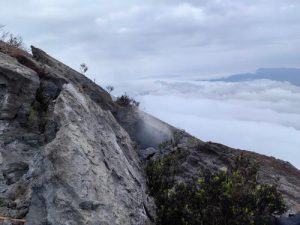

The surrounding terrain of this point is relatively undulating, with a slope of 5 ° -30 °. The terrain type is medium low mountain terrain, and the lithology of the stratum is basalt. The slope at this point has a slope of about 15 ° -30 °. The rock mass on the slope is fragmented, with a block diameter of 10-30cm and an angular shape. There are many trees around, with a height of about 5-18m and a thickness of about 10-20cm. Herbs, shrubs, and other vegetation can be seen on the slope. The slope gradient of the collapse source area is about 30 °, and the rock structure is fragmented, presenting a fragmented to scattered shape with a block diameter of 20-30cm and an angular shape. Herbs and shrubs can be seen on the slope surface. The collapse path rolls downstream along the slope. At present, the slope is in a basically stable state, and under the action of heavy rain or earthquakes, the stones on the slope will roll down along the slope. The slope is currently in a basically stable state, with landslides occurring mainly during the rainy season. The dry season has little impact on the safety of passing vehicles and pedestrians, and the degree of harm is low.
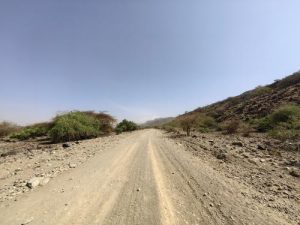
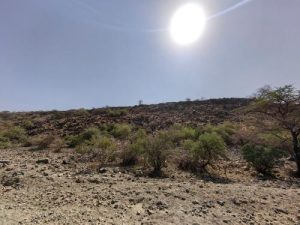
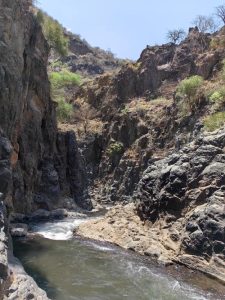
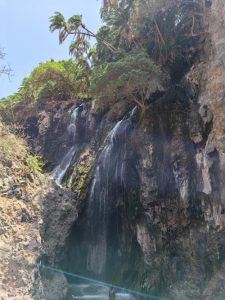
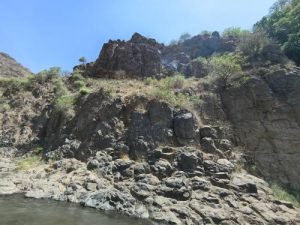
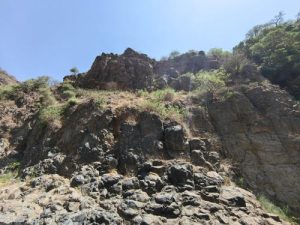
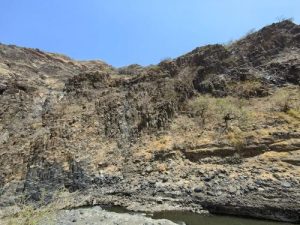

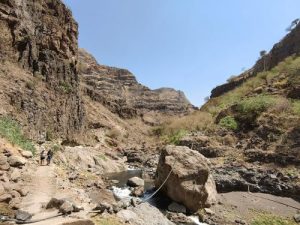
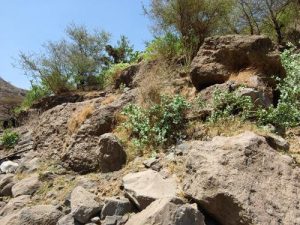
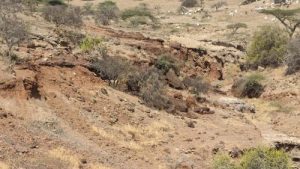
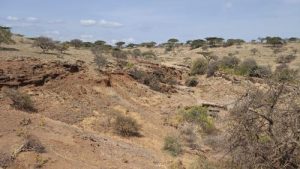
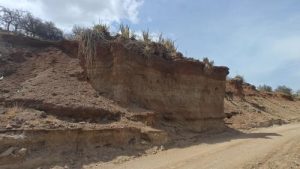
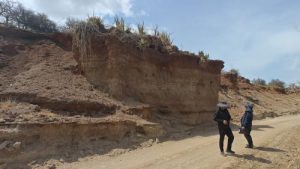

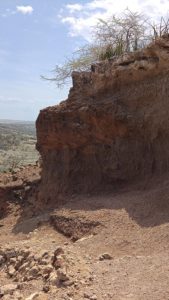
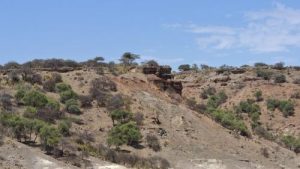
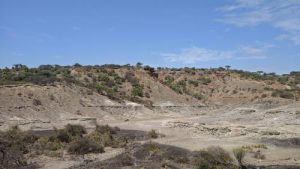
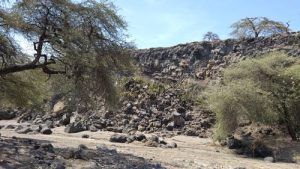
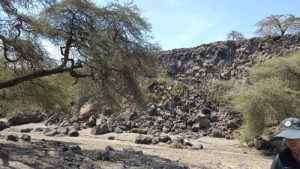
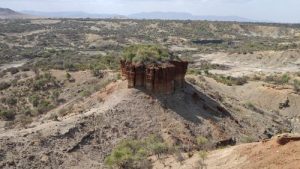
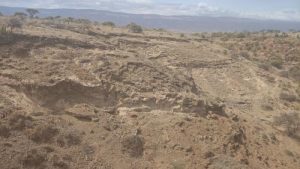

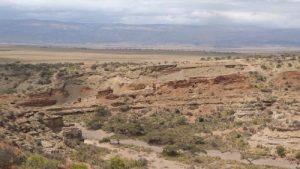
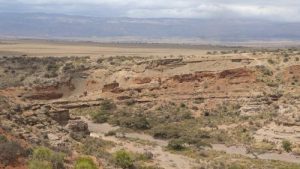
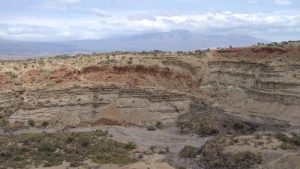
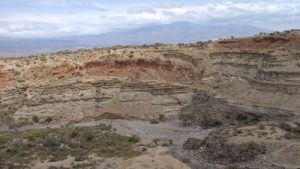
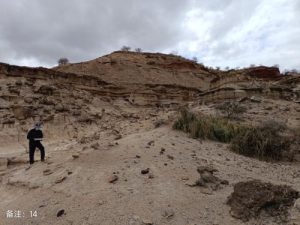
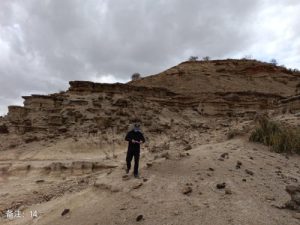
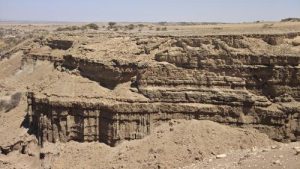
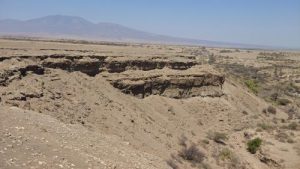
© 2025 Ngorongoro Lengai UNESCO Global Geopark. All Rights Reserved.